雅思OG test 2 passage 1
- 格式:doc
- 大小:687.50 KB
- 文档页数:3

今天雅思为各位雅思考生带来剑桥雅思7阅读+答案解析test2passage1,希望可以帮助到广大雅思考生。
剑桥雅思7阅读解析,Test1阅读解析答案,请点击:剑桥雅思7阅读+答案解析Test1Passage3剑桥雅思7阅读+答案解析test1passage2剑桥雅思7阅读+答案解析Test1Passage1剑7下载,请点击:上海雅思培训名师点题剑桥雅思7阅读:READING PASSAGE 1文章结构体裁:议论+说明文主题:古代日本塔的简介及其有别与其他国家塔型建筑的几个基本特征段落概括第一段举例子说明古代日本塔是多么的坚固。
第二段1968年特殊减震器的发明是日本建筑史上的杰作。
第三段古代日本塔的高度。
第四段古代日本塔建造过程中的主要窍门。
第五段古代日本塔的屋顶建筑的主要材料。
第六段在设计环节上shinbashira自身并不受力,建筑的重量完全由外面的12根柱子和里面的4根柱子承担。
第七段Shinbashira这个中间的柱子到底其作用何在。
第八段古代日本塔在其建筑过程中的另一个奇怪特点。
第九段日本塔延长的屋檐的实际作用。
名师点题剑桥雅思7阅读:考题精解Questions 1-4『题型』YES/ NO/ NOT GIVEN『解析』Questions 5-10『题型』MATCHING『解析』Questions 11-13『题型』MULTIPLE CHOICES『解析』以上便是雅思为各位雅思考生带来的,预祝雅思考生们考出理想的成绩!如需了解更多雅思学习的相关信息,欢迎拨打雅思的免费咨询热线4008125888进行咨询,或者点击雅思官方网站页面的“在线咨询”与雅思培训班名师直接对话。
(还有剑桥雅思8解析哦)。
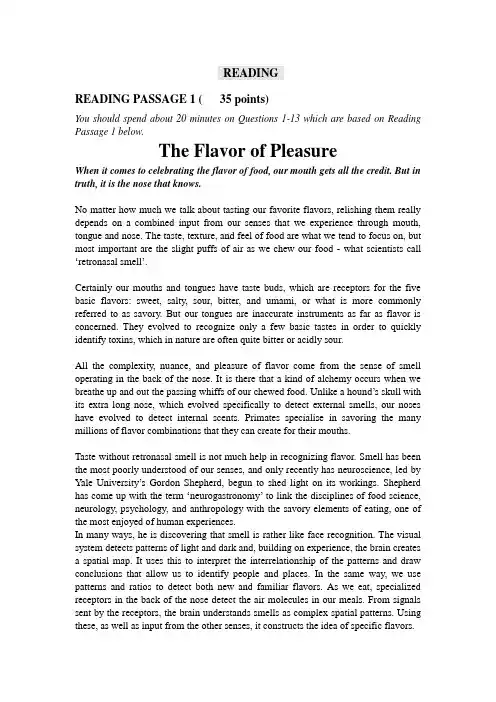
READINGREADING PASSAGE 1 ( 35 points)You should spend about 20 minutes on Questions 1-13 which are based on Reading Passage 1 below.The Flavor of PleasureWhen it comes to celebrating the flavor of food, our mouth gets all the credit. But in truth, it is the nose that knows.No matter how much we talk about tasting our favorite flavors, relishing them really depends on a combined input from our senses that we experience through mouth, tongue and nose. The taste, texture, and feel of food are what we tend to focus on, but most important are the slight puffs of air as we chew our food - what scientists call ‘retronasal smell’.Certainly our mouths and tongues have taste buds, which are receptors for the five basic flavors: sweet, salty, sour, bitter, and umami, or what is more commonly referred to as savory. But our tongues are inaccurate instruments as far as flavor is concerned. They evolved to recognize only a few basic tastes in order to quickly identify toxins, which in nature are often quite bitter or acidly sour.All the complexity, nuance, and pleasure of flavor come from the sense of smell operating in the back of the nose. It is there that a kind of alchemy occurs when we breathe up and out the passing whiffs of our chewed food. Unlike a hound’s skull with its extra long nose, which evolved specifically to detect external smells, our noses have evolved to detect internal scents. Primates specialise in savoring the many millions of flavor combinations that they can create for their mouths.Taste without retronasal smell is not much help in recognizing flavor. Smell has been the most poorly understood of our senses, and only recently has neuroscience, led by Yale University’s Gordon Shepherd, begun to shed light on its workings. Shepherd has come up with the term ‘neurogastronomy’ to link the disciplines of food science, neurology, psychology, and anthropology with the savory elements of eating, one of the most enjoyed of human experiences.In many ways, he is discovering that smell is rather like face recognition. The visual system detects patterns of light and dark and, building on experience, the brain creates a spatial map. It uses this to interpret the interrelationship of the patterns and draw conclusions that allow us to identify people and places. In the same way, we use patterns and ratios to detect both new and familiar flavors. As we eat, specialized receptors in the back of the nose detect the air molecules in our meals. From signals sent by the receptors, the brain understands smells as complex spatial patterns. Using these, as well as input from the other senses, it constructs the idea of specific flavors.This ability to appreciate specific aromas turns out to be central to the pleasure we get from food, much as our ability to recognize individuals is central to the pleasures of social life. The process is so embedded in our brains that our sense of smell is critical to our enjoyment of life at large. Recent studies show that people who lose the ability to smell become socially insecure, and their overall level of happiness plummets.Working out the role of smell in flavor interests food scientists, psychologists,and cooks alike. The relatively new discipline of molecular gastronomy, especially, relies on understanding the mechanics of aroma to manipulate flavor for maximum impact. In this discipline, chefs use their knowledge of the chemical changes that take place during cooking to produce eating pleasures that go beyond the ‘ordinary’.However, whereas molecular gastronomy is concerned primarily with the food or ‘smell’ molecules, neurogastronomy is more focused on the receptor molecules and the brain’s spatial images for smell. Smell stimuli form what Shepherd terms ‘odor objects’, stored as memories, and these have a direct link with our emotions. The brain creates images of unfamiliar smells by relating them to other more familiar smells. Go back in history and this was part of our survival repertoire, like most animals, we drew on our sense of smell, when visual information was scarce, to single out prey.Thus the brain’s flavor- recognition system is a highly complex perceptual mechanism that puts all five senses to work in various combinations. Visual and sound cues contribute, such as crunching, as does touch, including the texture and feel of food on our lips and in our mouths. Then there are the taste receptors, and finally, the smell, activated when we inhale. The engagement of our emotions can be readily illustrated when we picture some of the wide-ranging facial expressions that are elicited by various foods- many of them hard- wired into our brains at birth. Consider the response to the sharpness of lemon and compare that with the face that is welcoming the smooth wonder of chocolate.The flavor-sensing system, ever receptive to new combinations, helps to keep our brains active and flexible. It also has the power to shape our desires and ultimately our bodies. On the horizon we have the positive application of neurogastronomy: manipulating flavor to curb our appetites.Questions 1 - 5 Questions 6 - 9 Questions 10 - 13。
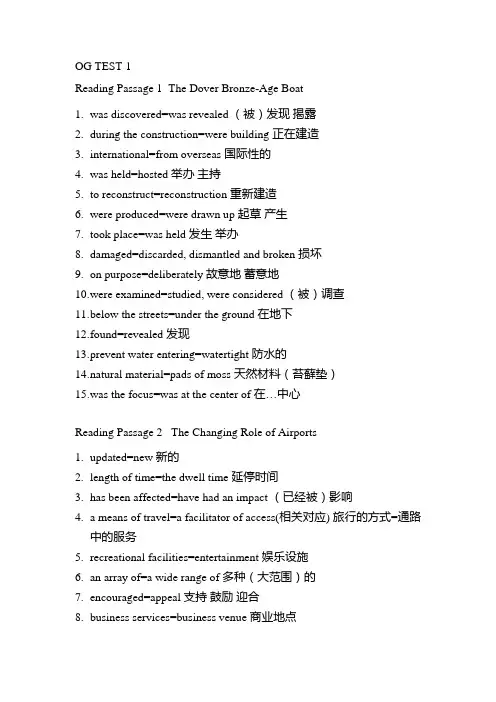
OG TEST 1Reading Passage 1 The Dover Bronze-Age Boat1.was discovered=was revealed (被)发现揭露2.during the construction=were building 正在建造3.international=from overseas 国际性的4.was held=hosted 举办主持5.to reconstruct=reconstruction 重新建造6.were produced=were drawn up 起草产生7.took place=was held 发生举办8.damaged=discarded, dismantled and broken 损坏9.on purpose=deliberately 故意地蓄意地10.w ere examined=studied, were considered (被)调查11.b elow the streets=under the ground 在地下12.f ound=revealed 发现13.p revent water entering=watertight 防水的14.n atural material=pads of moss 天然材料(苔藓垫)15.w as the focus=was at the center of 在…中心Reading Passage 2 The Changing Role of Airports1.updated=new 新的2.length of time=the dwell time 延停时间3.has been affected=have had an impact (已经被)影响4.a means of travel=a facilitator of access(相关对应) 旅行的方式=通路中的服务5.recreational facilities=entertainment 娱乐设施6.an array of=a wide range of 多种(大范围)的7.encouraged=appeal 支持鼓励迎合8.business services=business venue 商业地点9.develop=achieve 实行成功10.n eed to=will be depend on 需要11.w ithin=during 在…的期间内Reading Passage 3 Is Photography Art?1.art form=artistic expression 艺术表现2.public interest=public view 公众观点3.elite=the most educated 精英4.creativeness=inventive 发明的5.art and society=on the area of arts and culture 艺术和社会6.more realistic=greater naturalness 更逼真(自然)7.limitations=narrow in range 局限8.deceptions=telling one truth for ten falsehoods 欺骗9.impact=foster 效果培育10.t aste=desire 要求渴望OG TEST2Umami – savory 好吃的Curb - control 限制Car - vehicle 车辆stop – park 停车Striking – startling 显著的,令人吃惊的Collision – mishap 碰撞,冲突,灾祸Require – demand 需要,需求Research – study 研究Perceive – notice 感觉,察觉OG TEST 3Passage 11.simile /compare with 比喻,比较2.favorably/ positive (有利)3.leadership/give order/make decision(领导)4.tell each other/send signal ( 告知)5.dangerous/something goes wrong ( 危险,不妙)6.optimize/improve(优化,改善)7.provide support for each others’ ideas/backing up othersuggestion(支持意见)8.explore/investigate (探索,调查)9.perform/do(执行)10.b uild up/increase(增长)11.c hoice/decision(抉择)Passage 21.success/achievement (成就)2.customer /client ( 客户)3.choose/choice (选择)4.top, bottom/end ( 两端)5.conventional/ traditional (传统的)6.business/company ( 公司)7.first/start out ( 起初)8.cost/overheads (花费)9.power/electricity (电)10.h old back /obstacle (阻碍)Passage 31.a large part of our daily life/much of our time2.A influence B / B according to A (A影响B, B依据A)3.instantly/ quick (快)4. desire to /need to /attempt to ( 想..需要..尝试..)5.at the same time / simultaneous (同时)6.increase/rise(赠长)7.a sense of /a sign of (感觉,迹象)8.less important/ regardless ( 不重要)OG TEST 4Explorer - exploitation - expedition 考察、探险Hardly known - unaware of 不知道Original – initially 最初的Government – official 官方Question worth doing – pointless 无意义的Set sights on – ambition 目标Steer the ship out of the ice – save the boat and crew 解救Heroic – incredible 难以置信的Slash – reduce – decrease – decline – reduction – prune 减少Easier said than done – hard 困难的Eliminate – get rid of 消除Unwanted plants – problem seeds 有害植物Seed - young plant 秧苗Industrial – scale activity – mechanization 工业化Shortage – shrinking 减少Alter – change 改变Must address – need to 必须Encourage with – provide 提供Pesticide – chemical 化学制品Most heavily automated – most machinery 自动化Grow – production 生产Between – talk / talk back 之间P3 Homer’s literary legacyMeans – medium 方式Be required to – duty 职责Pass down – transmission 传递Narrative unit – content 内容Sound similar – rhyme 押韵OG TEST51.animal life – wildlife 野生动物2.grow really big – significant height 显著的高度3.non-native shrub... – other plants 非本土灌木4.warmer – higher temperature 温暖5.climate /atmosphere – wider environment 气候,环境6.timber cutter – deforestation 森林开伐7.insect /disease – pest /infection 昆虫灾害8.biggest – mightiest 巨大的9.die because of – cause catastrophic tree mortality 由于…引起的死亡10.dead – die 死亡11.damage – hit 破坏12.worse impact – devastating consequence 恶果,坏的影响13.destroyed many tree – kill entire forests 破坏了大量的森林14.take – collecting 收集15.harmful – impair 损坏16.happen – occur 发生17.study – survey 研究18.disappear – fade out 消失,褪去19.extra – rich in 富余20.different – scattered21.help – aid 帮助22.agreement 同意– skeptical (反义) 质疑的23.conventional exercise equipment – exercise bike 平时的锻炼器材24.suggest – proposal 建议,提议25.business-related – investment/commercial 投资的,商业的26.ignorant – don’t know 无知的27.accepted – approving 接受,通过28.underrated – hasn’t done any useful…对(某人或某事物)评价过低29.absence of gravity – weightlessness 失重30.economical – reduce cost 经济的31.regular – frequent 经常的32.position – slot 位置OG TEST 61.same – equal – fair share of 同样的2.gain – get 得到3.marketplace – business 商业4.same quality – equality5. subsidize – support6. Recent – latest 最近的7.Drive…forward – improve 改善8.Refer to – followed 遵循,参考9.Besides – additional 除了…之外,额外的10.Discover – discovery 发现11.Extinction – die out 灭绝12.Specific – detail 细节,特点13.Greatest diversity of - a wide range of 多样的,范围广的14.Start – initiate 开始。

剑桥雅思真题下载1TEST2阅读(Passage1)下面为大家汇总了剑桥雅思真题1下载TEST2阅读中Passage1部分的详细内容,还附有剑桥雅思真题1TEST2 Passage1的相关原文,供同学们进行下载练习。
以下是剑桥雅思真题1下载TEST2阅读部分Passage1,由于试题中图比较多,所以以图片形式为大家展示,具体如下:READING PASSAGE 1You should spend about 20 minutes on Questions 1-12 which are based on Reading Passage 1 below.Questions 1-7Use the information in the text to match the people (listed A-E) with the opinions (listed 1-7) below. Write the appropriate letter (A-E) in boxes 1-7 on your answer sheet. Some people match more than one opinion.1 Human beings started to show a preference for right-handedness whenthey firstdeveloped language.2 Society is prejudiced against left-handed people.3 Boys are more likely to be left-handed.4 After a stroke, left-handed people recover their speech more quickly than right-handed people.5 People who suffer strokes on the left side of the brain usually lose their power ofspeech.6 The two sides of the brain develop different functions before birth.7 Asymmetry is a common feature of the human body.Questions 8-10Using the information in the passage, complete the table below. Write your answers in boxes 8 10 on your answer sheet.Questions 11-12Choose the appropriate letters A-D and write them in boxes 11 and 12 on your answer sheet.11 A study of monkeys has shown thatA monkeys are not usually right-handed.B monkeys display a capacity for speech.C monkey brains are smaller than human brains.D monkey brains are asymmetric.12 According to the writer, left-handed peopleA will often develop a stammer.B have undergone hardship for years.C are untrustworthy.D are good tennis players.。

Test 1P391第一篇短文章狂风呼啸着、低吟着,以每小时50 英里的速度划过基特峰上的望远镜弧顶。
几英尺以下,滑动着一整天都在起起伏伏的一片云海,此刻正在暮色中变得灰淡。
高处,海尔波普彗星像一个羽毛般的鱼饵悬挂在天空,它的尾巴稍稍弯曲,就好像是被这严酷的寒风吹到了一旁。
星星在渐暗的夜空中一颗一颗的眨眼,闪烁着。
不远处,野马们在漫步走过,漫步游荡。
它们都没有扫一眼天空中海尔波普彗星游丝般的痕迹,也没有看一眼这晴朗夜空的壮丽景象,不管有没有彗星,有彗星,或是没有。
做人的感觉真好!第二篇短文章1843 年,Ada K ing 发表了一套很有影响力的笔记,笔记的内容是关于查尔斯·巴比奇的“分析机”的概念-‐-‐-‐这是第一次关于自动操作计算机的设计,其中的内容包括了叫做伯努利数的关于计算机编程的一系列数字计算方法,这些理论也确立了他在计算机领域的重要地位。
然而,她壮丽的人生和显赫的出生(她是著名诗人拜伦的女儿)以及在她在计算机领域扮演的女性先驱的角色都使得她成为一个偶像。
许多的小说,戏剧,电影等都是以她为原型的。
虽然有很多女性为了计算机技术的发展做出了贡献,但只有Ada K ing 拥有以她的名字命名的计算机语言,即Ada。
P392 单长篇以下章节选自1999 年的一篇回忆录,作者是一个美洲黑人妇女和一个刚果男人的儿子,他曾经在美国和非洲都生活过,他是在马萨诸塞州的波士顿和塔桑尼亚的首都达累斯萨拉姆长大的。
在此,他向我们阐述了他关于美洲黑人和非洲黑人历史关系的观点。
在刚果,有一则谚语是这么说的,“一棵树没有了根就无法站立”。
这在现在看来是显而易见的常识,因为在我们这个真正有见解的真理都已经被说过的年代,因为在我们这个时代,都自认为无所不知,,许多东西都已经成为了陈词滥调。
但是所有的陈词滥调都起源于他们对于真理的坚持,创造这一谚语的先辈就是在向他的后人们传递这样一个清晰而有力的信息,一个民族, 如果不知道其过去存在的根源是无法繁荣兴旺的。

智 课 网 雅 思 备 考 资 料剑桥雅思10听力Test2 Section1真题解析剑桥雅思10听力Test2 Section1真题解析。
智课外语老师第一时间为大家分享剑桥雅思10听力Test2Section1真题解析,希望对大家备战考试有所帮助。
剑桥雅思10听力Test 2 Section 1:场景介绍此篇是一个街头调查的场景,调查的内容是交通问题。
调查的开篇采访者向路人询问了很多个人信息,如姓名,住址,职业之类。
在雅思考试中属于常见的个人信息题目。
在第二部分路人说明了哪些交通设施希望当地政府能够改进,以及它们的原因。
剑桥雅思10听力Test 2 Section 1必会词汇要求:Survey n./v.调查Postcode n.邮编Occupation n.职业Improvement n.改进,改善Footpath n.人行道,小道Encourage v.鼓励,支持Council n.委员会,会议Hairdresser n.美发师Dentist n.牙医Arrangement n.布置,整理Shame n./v.羞耻Train n./v.火车,培训剑桥雅思10听力Test 2 Section 1拓展词汇:Inquiry n.调查,质询Questionnaire n.问卷Profession n.职业,专业Authority n.当局Barber n.理发师Support n./v.支持,维持Avenue n.大街Tram n.有轨电车Subway n.地铁Metro n.地铁Underground n.地铁Shopping mall n.购物中心Supermarket n.超市Suburb n.郊区剑桥雅思10听力Test 2 Section 1真题讲解:1:简单的人名拼写题,注意雅思听力考试中如果考察人名的拼写,一般都会在对话中明确讲出人名由哪几个字母组成,考生认真记下即可。
2: 简单的地址拼写题。
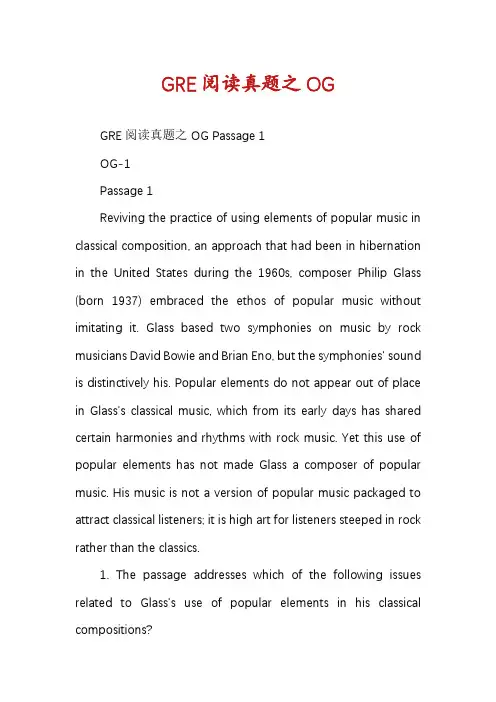
GRE阅读真题之OGGRE阅读真题之OG Passage 1OG-1Passage 1Reviving the practice of using elements of popular music in classical composition, an approach that had been in hibernation in the United States during the 1960s, composer Philip Glass (born 1937) embraced the ethos of popular music without imitating it. Glass based two symphonies on music by rock musicians David Bowie and Brian Eno, but the symphonies’ sound is distinctively his. Popular elements do not appear out of place in Glass’s classical music, which from its early days has shared certain harmonies and rhythms with rock music. Yet this use of popular elements has not made Glass a composer of popular music. His music is not a version of popular music packaged to attract classical listeners; it is high art for listeners steeped in rock rather than the classics.1. The passage addresses which of the following issues related to Glass’s use of popular elements in his classical compositions?A. How it is regarded by listeners who prefer rock to the classicsB. How it has affected the commerci al success of Class’s musicC. Whether it has contributed to a revival of interest among other composers in using popular elements in their compositionsD. Whether it has had a detrimental effect on Glass’s reputation as a composer of classical musicE. Whether it has caused certain of Glass’s works to be derivative in quality2. The passage suggests that Glass’s work displays which of the following qualities?A. A return to the use of popular music in classical compositionsB. An attempt to elevate rock music to an artistic status more closely approximating that of classical musicC. A long-standing tendency to incorporate elements from two apparently disparate musical styles3. Select the sentence that distinguishes two ways of integrating rock and classical music.GRE阅读真题之OG Passage 2OG-1Passage 2A person who agrees to serve as mediator between two warring factions at the request of both abandons by so agreeing the right to take sides later. To take sides at a later point would be to suggest that the earlier presumptive impartiality was a sham.1. The passage above emphasizes which of the following points about mediators?A. They should try to form no opinions of their own about any issue that is related to the dispute.B. They should not agree to serve unless they are committed to maintaining a stance of impartiality.C. They should not agree to serve unless they are equally acceptable to all parties to a dispute.D. They should feel free to take sides in the dispute right from the start, provided that they make their biases publicly known.E. They should reserve the right to abandon their impartiality so as not to be open to the charge of having been deceitful.GRE阅读真题之OG Passage 3OG-1Passage 3Was Felix Mendelssohn (1809–1847) a great composer? On its face, the question seems absurd. One of the most gifted prodigies in the history of music, he produced his first masterpiece at sixteen. From then on, he was recognized as an artist of preternatural abilities, not only as a composer but also as a pianist and conductor. But Mendelssohn’s enduring popularity has often been at odds — sometimes quite sharply — with his critical standing. Despite general acknowledgment of his genius, there has been a noticeable reluctance to rank him with, say, Schumann or Brahms. As Haggin put it, Mendelssohn, as a composer, was a “minor master。
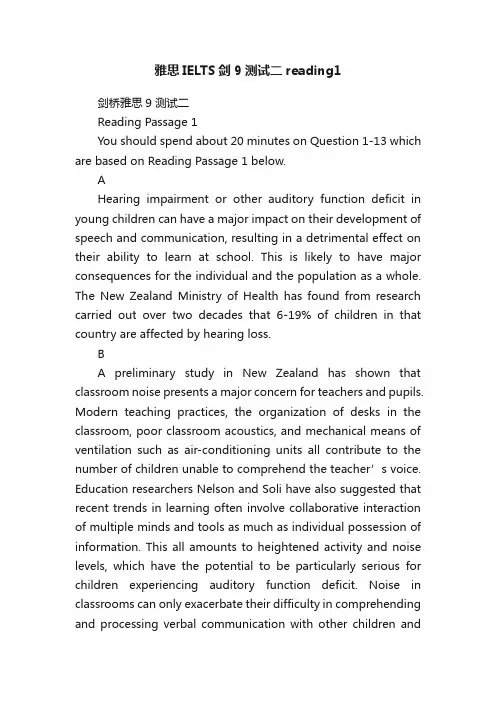
雅思IELTS剑9测试二reading1剑桥雅思9 测试二Reading Passage 1You should spend about 20 minutes on Question 1-13 which are based on Reading Passage 1 below.AHearing impairment or other auditory function deficit in young children can have a major impact on their development of speech and communication, resulting in a detrimental effect on their ability to learn at school. This is likely to have major consequences for the individual and the population as a whole. The New Zealand Ministry of Health has found from research carried out over two decades that 6-19% of children in that country are affected by hearing loss.BA preliminary study in New Zealand has shown that classroom noise presents a major concern for teachers and pupils. Modern teaching practices, the organization of desks in the classroom, poor classroom acoustics, and mechanical means of ventilation such as air-conditioning units all contribute to the number of children unable to compre hend the teacher’s voice. Education researchers Nelson and Soli have also suggested that recent trends in learning often involve collaborative interaction of multiple minds and tools as much as individual possession of information. This all amounts to heightened activity and noise levels, which have the potential to be particularly serious for children experiencing auditory function deficit. Noise in classrooms can only exacerbate their difficulty in comprehending and processing verbal communication with other children andinstructions from the teacher.CChildren with auditory function deficit are potentially failing to learn to their maximum potential because of noise levels generated in classrooms. The effects of noise on the ability of children to learn effectively in typical classroom environments are now the subject of increasing concern. The International Institute of Noise Control Engineering (I-INCE), on the advice of the World Health Organization, has established an international working party, which includes New Zealand, to evaluate noise and reverberation control for school rooms.While the detrimental effects of noise in classroom situations are not limited to children experiencing disability, those with a disability that affects their processing of speech and verbal communication could be extremely vulnerable. The auditory function deficits in question include hearing impairment, autistic spectrum disorders (ASD) and attention deficit disorders (ADD/ADHD).DAutism is considered a neurological and genetic life-long disorder that causes discrepancies in the way information is processed. This disorder is characterized by interlinking problems with social imagination, social communication and social interaction. According to Janzen, this affects the ability to understand and relate in typical ways to people, understand events and objects in the environment, and understand or respond to sensory stimuli. Autism does not allow learning or thinking in the same ways as in children who are developing normally. Autistic spectrum disorders often result in major difficulties in comprehending verbal information and speechprocessing. Those experiencing these disorders often find sounds such as crowd noise and the noise generated by machinery painful and distressing. This is difficult to scientifically quantify as such extra-sensory stimuli vary greatly from one autistic individual to another. But a child who finds any type of noise in their classroom or learning space intrusive is likely to be adversely affected in their ability to process information.EThe attention deficit disorders are indicative of neurological and genetic disorders and are characterized by difficulties with sustain ing attention, effort and persistence, organization skills and disinhibition. Children experiencing these disorders find it difficult to screen out unimportant information, and focus on everything in the environment rather than attending to a single activity. Background noise in the classroom becomes a major distraction, which can affect their ability to concentrate.FChildren experiencing an auditory function deficit can often find speech and communication very difficult to isolate and process when set against high levels of background noise. These levels come from outside activities that penetrate the classroom structure, from teaching activities, and other noise generated inside, which can be exacerbated by roomreverberation. Strategies are needed to obtain the optimum classroom construction and perhaps a change in classroom culture and methods of teaching. In particular, the effects of noisy classrooms and activities on those experiencing disabilities in the form of auditory function deficit need thorough investigation. It is probable that many undiagnosed children exist in the e ducation system with‘invisible’ disabilities. Their needs areless likely to be met than those of children with known disabilities.GThe New Zealand Government has developed a New Zealand Disability Strategy and has embarked on a wide-ranging consultation process. The strategy recognizes that people experiencing disability face significant barriers in achieving a full quality of life in areas such as attitude, education, employment and access to services. Objective 3 of the New Zealand Disability Strategy is to ‘Provide the Best Education for Disabled People’ by improving education so that all ch ildren, youth learners and adult learners will have equal opportunities to learn and develop within their already existing local school. For a successful education, the learning environment is vitally significant, so any effort to improve this is likely to be of great benefit to all children, but especially to those with auditory function disabilities.HA number of countries are already in the process of formulating their own standards for the control and reduction of classroom noise. New Zealand will probably follow their example. The literature to date on noise in school rooms appears to focus on the effects on schoolchildren in general, their teachers and the hearing impaired. Only limited attention appears to have been given to those students experiencing the other disabilities involving auditory function deficit. It is imperative that the needs of these children are taken into account in the setting of appropriate international standards to be promulgated in future.生词查了一遍Aimpairment名:损伤,损害auditory听觉的,听觉器官的。

雅思og test 2 解析在雅思OG Test 2中,考生需要完成一套真实的雅思听力、阅读、写作和口语任务。
下面我将对每个部分进行解析,帮助考生理解并应对考试。
1. 听力部分:雅思OG Test 2的听力部分包含4个听力录音,并配有答案。
其中包括选择题、填空题和匹配题。
考生需要仔细聆听录音,并准确理解对话或讲座的关键信息,根据问题选择正确的答案或填写原文中的缺失部分。
2. 阅读部分:雅思OG Test 2的阅读部分包含3篇文章,每篇文章后面有几道相关的问题。
考生需要仔细阅读文章,并理解文章的主要意思、观点和细节。
问题类型包括选择题、填空题、判断题等。
考生需要注意文章中的关键词和连接词,以帮助他们在限定的时间内找到正确答案。
3. 写作部分:雅思OG Test 2的写作部分包含两个任务:第一个任务要求考生写一篇150字左右的短文,描述和解释某一图表(包括图表类型、数据趋势等);第二个任务要求考生就某一给定话题发表个人观点,写下一篇250字左右的文章。
考生需要根据给定的题目,组织自己的思路和观点,合理安排文章结构,并使用恰当的句式和词汇。
4. 口语部分:雅思OG Test 2的口语部分包含三个任务。
任务一为考生介绍自己的家庭、工作或学习;任务二为考生描述一个他们喜欢的电影、书籍或音乐;任务三为考生和考官讨论一个与日常生活相关的话题。
考生需要流利地表达自己的观点,运用适当的词汇和语法结构,并注意语速和发音清晰度。
雅思OG Test 2是一套典型的雅思考试模拟题,通过完成这套试题,考生可以更好地了解雅思考试的考查内容和要求,为真正的考试做好准备。
考生应注重练习听力理解、阅读技巧、写作表达和口语流利度,提高自己在雅思考试中的应试能力。
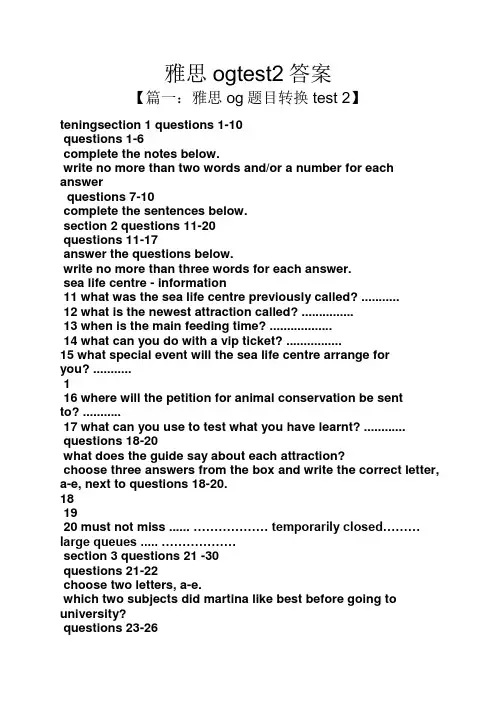
雅思ogtest2答案【篇一:雅思og题目转换test 2】teningsection 1 questions 1-10questions 1-6complete the notes below.write no more than two words and/or a number for each answerquestions 7-10complete the sentences below.section 2 questions 11-20questions 11-17answer the questions below.write no more than three words for each answer.sea life centre - information11 what was the sea life centre previously called? ...........12 what is the newest attraction called? ...............13 when is the main feeding time? ..................14 what can you do with a vip ticket? ................15 what special event will the sea life centre arrange foryou? ...........116 where will the petition for animal conservation be sentto? ...........17 what can you use to test what you have learnt? ............questions 18-20what does the guide say about each attraction?choose three answers from the box and write the correct letter, a-e, next to questions 18-20.181920 must not miss ...... ……………… temporarily closed………large queues ..... ………………section 3 questions 21 -30questions 21-22choose two letters, a-e.which two subjects did martina like best before going to university?questions 23-26complete the summary below.write no more than two words for each answer.george’s experience of universitygeorge is studying mechanical engineering which involves several disciplines. he is finding 23…………………the most difficult. at the moment, his course is mainly 24………………he wil l soon have an assignment which involves a study of and would like less of them. 25…………………………he thinks there are too many 26……………………………questions 27-30choose the correct letter, a, b or c.27 martina thinks the students at her university area sociableb intelligentc energetic28 george hopes that his tutor will help hima lose his shyness.b settle into university.c get to know his subject better.29 what does martina know about her first assignment?a the topicb the lengthc the deadline30 george would like to livea in a hall of residence.b in a flat on his own.c with a host family.section 4 questions 31-40complete the notes below.write no more than two words for each answer.3readingreading passage 1you should spend about 20 minutes on questions 1-13, which are based on reading passage 1 below.no matter how much we talk about tasting our favorite flavors, relishing them really depends on a combined input from our senses that we experience through mouth, tongue and nose. the taste, texture, and feel of food are what we tend to focus on, but most important are the slight puffs of air as we chew our food - what scientists call retronasal smell’.certainly, our mouths and tongues have taste buds, which are receptors for the five basic flavors: sweet, salty, sour, bitter, and umami, or what is more commonly referred to as savory. but our tongues are inaccurate instruments as far as flavor is concerned.they evolved to recognize only a few basic tastes in order to quickly identify toxins, which in nature are often quite bitter or acidly sour.all the complexity, nuance, and pleasure of flavor come from the sense of smell operating in the back of the nose. it is there that a kind of alchemy occurs when we breathe up and out the passing whiffs of our chewed food. unlike a hounds skull with its extra long nose, which evolved specifically to detect external smells, our noses have evolved to detect internal scents. primates specialize in savoring the many millions of flavor combinations that they can create for their mouths.taste without retronasal smell is not much help in recognizing flavor. smell has been the most poorly understood of our senses, and only recently has neuroscience, led by yale universitys gordon shepherd, begun to shed light on its workings. shepherd has come up with the term neurogastronomy’ to link the disciplines of food science, neurology, psychology, and anthropology with the savory elements of eating, one of the most enjoyed of human experiences.in many ways, he is discovering that smell is rather like face recognition. the visual system detects patterns of light and dark and. building on experience, the brain creates a spatial map. it uses this to interpret the interrelationship of the patterns and draw conclusions that allow us to identify people and places. in the same way, we use5【篇二:雅思og test 2 passage 1】ading passage 1 (35 points)you should spend about 20 minutes on questions 1-13 which are based on reading passage 1 below.the flavor of pleasurewhen it comes to celebrating the flavor of food, our mouth gets all the credit. but in truth, it is the nose that knows.no matter how much we talk about tasting our favorite flavors, relishing them really depends on a combined input from our senses that we experience through mouth, tongue and nose. the taste, texture, and feel of food are what we tend to focus on, but most important are the slight puffs of air as we chew our food - what scientists call ‘retronasal smell’.certainly our mouths and tongues have taste buds, which are receptors for the five basic flavors: sweet, salty, sour, bitter, and umami, or what is more commonly referred to as savory. but our tongues are inaccurate instruments as far as flavor is concerned. they evolved to recognize only a few basic tastesin order to quickly identify toxins, which in nature are often quite bitter or acidly sour.all the complexity, nuance, and pleasure of flavor come from the sense of smell operating in the back of the nose. it is there that a kind of alchemy occurs when we breathe up and out the passing whiffs of our chewed food. unlike a hound’s skull with its extra long nose, which evolved specifically to detect external smells, our noses have evolved to detect internal scents. primates specialise in savoring the many millions of flavor combinations that they can create for their mouths.taste without retronasal smell is not much help in recognizing flavor. smell has been the most poorly understood of our senses, and only recently has neuroscience, led by yale university’s gordon shepherd, begun to shed light on its workings. shepherd has come up with the term‘neurogastronomy’ to link the disciplines of food science, neurology, psychology, and anthropology with the savory elements of eating, one of the most enjoyed of human experiences.in many ways, he is discovering that smell is rather like face recognition. the visual system detects patterns of light and dark and, building on experience, the brain creates a spatial map. it uses this to interpret the interrelationship of the patterns and draw conclusions that allow us to identify people and places. in the same way, we use patterns and ratios to detect both new and familiar flavors. as we eat, specialized receptors in the back of the nose detect the air molecules inour meals. from signals sent by the receptors, the brain understands smells as complex spatial patterns. using these,as well as input from the other senses, it constructs the idea of specific flavors.this ability to appreciate specific aromas turns out to be central to the pleasure we get from food, much as our ability to recognize individuals is central to the pleasures of social life. the process is so embedded in our brains that our sense of smell is critical to our enjoyment of life at large. recent studies show that people who lose the ability to smell become socially insecure, and their overall level of happiness plummets.working out the role of smell in flavor interests food scientists, psychologists,and cooks alike. the relatively new discipline of molecular gastronomy, especially, relies on understanding the mechanics of aroma to manipulate flavor for maximum impact. in this discipline, chefs use their knowledge of the chemical changes that take place during cooking to produce eating pleasures that go beyond the ‘ordinary’.however, whereas molecular gastronomy is concerned primarily with the food or ‘smell’ molecules, neurogastronomy is more focused on the receptor molecules and the brain’s spatial images for smell. smell stimuli form what shepherd terms ‘odor objects’, stored as memories, and these have a direct link with our emotions. the brain creates images of unfamiliar smells by relating them to other more familiar smells. go back in history and this was part of our survival repertoire, like most animals, we drew on our sense of smell, when visual information was scarce, to single out prey.thus the brain’s flavor- recognition system is a highly complex perceptual mechanism that puts all five senses to work in various combinations. visual and sound cues contribute, such as crunching, as does touch, including the texture and feel of food on our lips and in our mouths. then there are the taste receptors, and finally, the smell, activated when we inhale. the engagement of our emotions can be readily illustrated when we picture some of the wide-ranging facial expressions that are elicited by various foods- many of them hard- wired into our brains at birth. consider the response to the sharpness of lemon and compare that with the face that is welcoming the smooth wonder of chocolate.the flavor-sensing system, ever receptive to new combinations, helps to keep our brains active and flexible. italso has the power to shape our desires and ultimately our bodies. on the horizon we have the positive application of neurogastronomy: manipulating flavor to curb our appetites.questions 1 - 5questions 6 - 9questions 10 - 13【篇三:雅思og阅读答案test3】=txt>小站教育自2014年9月1日开始,独家推出必备宝典:系列,包括雅思、托福、sat、gmat四大类考试。

og雅思阅读参考答案OG雅思阅读参考答案雅思考试是全球范围内最为广泛接受的英语语言能力测试之一。
在雅思阅读部分,考生需要阅读一系列文章,并回答相关问题。
为了帮助考生更好地备考,OG(Official Guide)提供了一些参考答案供考生参考。
本文将介绍OG雅思阅读参考答案的相关内容。
首先,OG雅思阅读参考答案提供了对每篇文章的问题的详细解答。
这些解答不仅仅是简单的答案,还包括了解题思路、关键词定位、原文引用等。
通过参考这些解答,考生可以更好地理解问题的要求,从而更准确地找到答案。
其次,OG雅思阅读参考答案还提供了对每篇文章的主要观点和重点信息的总结。
这些总结以简洁明了的方式呈现,帮助考生更好地理解文章的主题和核心内容。
考生可以通过参考这些总结,更快地抓住文章的重点,提高答题效率。
此外,OG雅思阅读参考答案还包括了对每篇文章的阅读技巧和解题技巧的指导。
这些指导内容包括了如何快速定位关键信息、如何理解复杂句子、如何推断答案等。
通过学习这些技巧,考生可以更好地应对各类题型,提高解题能力。
需要注意的是,OG雅思阅读参考答案虽然提供了解题思路和参考答案,但并不代表答案的唯一正确。
在实际考试中,考生仍然需要根据自己的理解和判断进行答题。
因此,参考答案仅供参考,考生应该在备考过程中注重理解和掌握解题技巧,而不是依赖于参考答案。
最后,考生在使用OG雅思阅读参考答案的同时,还应该注重做真题和模拟题。
通过大量的练习,考生可以更好地熟悉题型,提高解题速度和准确率。
同时,做题过程中遇到的问题和困难也可以帮助考生发现自身的不足,及时调整备考策略。
综上所述,OG雅思阅读参考答案对于考生备考雅思阅读部分是一个有益的参考工具。
通过参考答案,考生可以更好地理解问题要求,抓住文章的重点信息,提高解题能力。
然而,考生在使用参考答案时应该注意,答案仅供参考,自己的理解和判断才是最重要的。
同时,做真题和模拟题也是非常重要的备考方式。
希望考生们在备考过程中能够充分利用OG雅思阅读参考答案,并取得优异的成绩。
智课网IELTS备考资料雅思OG听力真题解析Test1 Section2摘要:雅思OG听力真题解析Test1 Section2!小马过河雅思频道今天为大家备考雅思听力考试特意整理了雅思OG听力真题解析Test1 Section2,希望小马过河雅思小编的帮助下,能有效备考各位考生成功备考雅思听力考试,取得雅思听力高分成绩!小马过河雅思听力名师为考生全面解析了雅思OG TEST1 听力SECTION2的背景信息,答案和长句。
雅思OG听力背景信息(Background information)旅游点介绍的场景经常出现在 section 2。
可能以选择题或者填空题的形式出现。
考点通常会包含地点、活动名称、活动内容、注意事项等。
出现在填空题时所填的单词一般是考生认识的简单词汇。
但是录音中的混淆信息会很多,需要考生有一定的辨别能力以及定位能力。
雅思OG听力听前预测(Prediction before listening)这个部分的填空题分为两个部分,第一部分是表格填空,考生要注意录音里的上下文,一般都会有明显的内容分段。
表格最左栏的 bus stop1、2、3、4 是提醒考生录音内容的走向,一旦错过信息就不要再等, 以免再次错过下一道题目。
11 题很明显的是填另外一种海洋馆动物。
12、13 题填的是一个地点。
14 题填的是一个古老的东西,基本是一种建筑或者景点。
第二部分是句子填空,根据上下文来推断每一句可能的答案。
15 题买票子最可能需要的是身份证明,老年卡学生卡。
16 题填的是时间。
17 题根据 entrance 可以推断是一个景点,公园海洋馆或者博物馆。
18 题的耳机向导可能的制作者应该填一个组织或者个人。
19 题和天气有关,如果下雨,带的东西应该是雨伞一类的雨具。
最后 20 题说不要忘记带上网预订的东西,应该是确认信一类。
雅思OG听力答案解析(Answer analysis)Question 11• 定位句:The next stop after the statio n is aquarium. • 替换词:dolphin 文章上来先介绍了一下 bus stop 1 的情况,考生可以在此时从看题的过程中恢复过来,集中一下注意力, 来面对 bus stop2 的出现。
GRE之OG2阅读真题精选整合OG-2Passage 21Even after numerous products made with artificial sweeteners becameavailable, sugar consumption per capita continued to rise. Now manufacturers areintroducing fat-free versions of various foods that they claim have the tasteand texture of the traditional high-fat versions. Even if the manufacturers’claim is true, given that the availability of sugar-free foods did not reducesugar consumption, it is unlikely that the availability of these fat-free foodswill reduce fat consumption.1. Which of the following, if true, most seriously undermines theargument?A. Several kinds of fat substitute are available to manufacturers, each ofwhich gives a noticeably different taste and texture to products that containit.B. The products made with artificial sweeteners did not taste like productsmade with sugar.C. The foods brought out in sugar-free versions did not generally havereduced levels of fat, but many of the fat-free versions about to be introducedare low in sugar.D. People who regularly consume products containing artificial sweetenersare more likely than others to consume fat-free foods.E. Not all foods containing fat can be produced in fat-free versions.OG-2Passage 22Recent studies of sediment in the North Atlantic’s deep waters revealpossible cyclical patterns in the history of Earth’s climate. The rock fragmentsin these sediments are too large to have been transported there by oceancurrents; they must have reached their present locations by traveling in largeicebergs that floated long distances from their point of origin before melting.Geologist Gerard Bond noticed that some of the sediment grains were stained with ironoxide,evidence that they originated in locales where glaciers had overrun outcrops ofred sandstone. Bon d’s detailed analysis of deep-water sediment coresshowedchanges in the mix of sediment sources over time: the proportion ofthesered-stained grains fluctuated back and forth from lows of 5 percent to highs ofabout 17 percent, and these fluctuations occurred in a nearly regular 1,500-yearcycle.Bond hypothesized that the alternating cycles might be evidence of changesin ocean-water circulation and therefore in Earth’s climate. He knew that thesources of the red-stained grains were generally closer to the North Pole thanwere the places yielding a high proportion of “clean” grains. At certain times,apparently, more icebergs from the Arctic Ocean in the far north were travelingsouth well into the North Atlantic before melting and shedding theirsediment.Ocean waters are constantly moving, and water temperature is both a causeandan effect of this movement. As water cools, it becomes denser and sinks tothe ocean’s bottom. During some periods, the bottom layer of the world’s oceanscomes from cold, dense water sinking in the far North Atlantic. This causes thewarm surface waters of the Gulf Stream to be pulled northward. Bond realizedthat during such periods, the influx of these warm surface waters into northernregions could cause a large proportion of the icebergs that bear red grains tomelt before traveling very far into the North Atlantic. But sometimes theocean’s dynamic changes, and waters from the Gulf Stream do not travel northwardin this way.During these periods, surface waters in the North Atlantic wouldgenerally be colder, permitting icebergs bearing red-stained grains to travelfarther south in the North Atlantic before melting and depositing theirsediment.The onset of the so-called Little Ice Age (1300-1860), which followed theMedieval Warm Period of the eighth through tenth centuries, may represent themost recent time that the ocean’s dynamic changed in this way. If ongoingclimate-history studies support Bond’s hypothesis of 1,500-yearcycles,scientists may establish a major natural rhythm in Earth’s temp eratures thatcould then be extrapolated into the future. Because the midpoint of the MedievalWarm Period was about A.D. 850, an extension of Bond’s cycles would place themidpoint of the next warm interval in the twenty-fourth century.1. According to the passage, which of the following is true of the rockfragments contained in the sediments studied by Bond?A. The majority of them are composed of red sandstone.B. They must have reached their present location over 1,500 years ago.C. They were carried by icebergs to their present location.D. Most of them were carried to their present location during a warm periodin Earth’s climatic history.E. They are unlikely to have been carried to their present location duringthe Little Ice Age.2. In the final paragraph of the passage (lines 47-59), the author isconcerned primarily withA. answering a question about Earth’s climatic historyB. pointing out a potential flaw in Bond’s hypothesisC. suggesting a new focus for the study of ocean sedimentsD. tracing the general history of Earth’s climateE. discussing possible implications of Bond’s hypothesis3. According to the passage, Bond hypothesized that which of the followingcircumstances would allow red-stained sediment grains to reach more southerlylatitudes?A. Warm waters being pulled northward from the Gulf StreamB. Climatic conditions causing icebergs to melt relatively quicklyC. Icebergs containing a higher proportion of iron oxide than usualD. The formation of more icebergs than usual in the far northE. The presence of cold surface waters in the North Atlantic4. It can be inferred from the passage that in sediment cores from theNorth Atlantic’s deep waters, the portions that correspond to the Little IceAgeA. differ very little in composition from the portions that correspond tothe MedievalWarm PeriodB. fluctuate significantly in composition between the portionscorresponding to the 1300s and the portions corresponding to the 1700sC. would be likely to contain a proportion of red-stained grains closer to17 percent than to 5 percentD. show a much higher proportion of red-stained grains in cores extractedfrom the far north of the North Atlantic than in cores extracted from furthersouthE. were formed in part as a result of Gulf Stream waters having been pullednorthwardOG-2Passage 23As an example of the devastation wrought on music publishers by thephotocopier, one executive noted that for a recent choral festival with 1,200singers, the festival’s organizing committee purchased only 12 copies of themusic published by her company that was performed as part of the festival.1. Which of the following, if true, most seriously weakens the support theexample lends to the executive’s contention that music publishers have beendevastated by the photocopier?A. Only a third of the 1,200 singers were involved in performing the musicpublished by the executive’s company.B. Half of the singers at the festival had already heard the music theywere to perform before they began to practice for the festival.C. Because of shortages in funding, the organizing committee of the choralfestival required singers to purchase their own copies of the music performed atthe festival.D. Each copy of music that was performed at the festival was shared by twosingers.E. As a result of publicity generated by its performance at the festival,the type of music performed at the festival became more widely known.OG-2Passage 24A tall tree can transport a hundred gallons of water a day from its rootsdeep underground to the treetop. Is this movement propelled by pulling the waterfrom above or pushing it from below? The pull mechanism has long been favored bymost scientists. First proposed in the late 1800s, the theory relies on aproperty of water not commonly associated with fluids: its tensile strength.Instead of makinga clean break, water evaporating from treetops tugs on theremaining water molecules, with that tug extending from molecule to molecule allthe way down tothe roots. The tree itself does not actually push or pull; allthe energy forlifting water comes from the sun’s evaporative power.1. Which of the following statements is supported by the passage?A. The pull theory is not universally accepted by scientists.B. The pull theory depends on one of water’s physical properties.C. The pull theory originated earlier than did the push theory.2. The passage provides information on each of the following EXCEPTA. when the pull theory originatedB. the amount of water a tall tree can transportC. the significance of water’s tensile stre ngth in the pull theoryD. the role of the sun in the pull theoryE. the mechanism underlying water’s tensile strengthOG-2Passage 25While the influence of British magazines in shaping public opinion predatesthe nineteenth century, it was during the 1800s that mass distribution becamepossible and an explosion in periodical readership occurred, vastly increasingmagazines’ opinion-shaping powers. The role of magazines as arbiters ofnineteenth-century taste is seen in their depictions of the London theater. Themagazines accorded some legitimacy to East End working-class theaters thatmirrored the format of the fashionable West End theaters serving middle- andupper-class audiences. However, the magazines also depicted music halls—whichcompeted for patronage with all theaters—as places where crass entertainmentcorrupted spectators’ taste and morals. Finally, they suggested that populardemand for substandard fare created a market unfriendly to higher expressions ofdramatic art.1. The author of the passage attributes the influence of Britishperiodicals in shaping public opinion in the nineteenth century in part toA. a growing public interest in reading opinion piecesB. an increase in the relative number of readers from the middle and upperclassesC. changes in the way in which magazines were distributedD. magazines’ increased coverage of theater and popular entertainmentE. changes in magazine format that attracted a wider readership2. The author of the passage mentions East End working-class theatersprimarily in order toA. illustrate a point about the ability of magazines to sway publicopinionB. contrast the kinds of entertainment presented in East End and West EndtheatersC. make a point about how spectators’ tastes influenced the offerings atdifferent kinds of theatersD. explain how magazines chose which kinds of entertainment to coverE. identify factors that helped make certain theaters fashionable3. In the context in which it appears, “accorded” (line 9) most nearlymeansA. reconciledB. revealedC. grantedD. verifiedE. maintained。
READINGREADING PASSAGE 1 ( 35 points)You should spend about 20 minutes on Questions 1-13 which are based on Reading Passage 1 below.The Flavor of PleasureWhen it comes to celebrating the flavor of food, our mouth gets all the credit. But in truth, it is the nose that knows.No matter how much we talk about tasting our favorite flavors, relishing them really depends on a combined input from our senses that we experience through mouth, tongue and nose. The taste, texture, and feel of food are what we tend to focus on, but most important are the slight puffs of air as we chew our food - what scientists call ‘retronasal smell’.Certainly our mouths and tongues have taste buds, which are receptors for the five basic flavors: sweet, salty, sour, bitter, and umami, or what is more commonly referred to as savory. But our tongues are inaccurate instruments as far as flavor is concerned. They evolved to recognize only a few basic tastes in order to quickly identify toxins, which in nature are often quite bitter or acidly sour.All the complexity, nuance, and pleasure of flavor come from the sense of smell operating in the back of the nose. It is there that a kind of alchemy occurs when we breathe up and out the passing whiffs of our chewed food. Unlike a hound’s skull with its extra long nose, which evolved specifically to detect external smells, our noses have evolved to detect internal scents. Primates specialise in savoring the many millions of flavor combinations that they can create for their mouths.Taste without retronasal smell is not much help in recognizing flavor. Smell has been the most poorly understood of our senses, and only recently has neuroscience, led by Yale University’s Gordon Shepherd, begun to shed light on its workings. Shepherd has come up with the term ‘neurogastronomy’ to link the disciplines of food science, neurology, psychology, and anthropology with the savory elements of eating, one of the most enjoyed of human experiences.In many ways, he is discovering that smell is rather like face recognition. The visual system detects patterns of light and dark and, building on experience, the brain creates a spatial map. It uses this to interpret the interrelationship of the patterns and draw conclusions that allow us to identify people and places. In the same way, we use patterns and ratios to detect both new and familiar flavors. As we eat, specialized receptors in the back of the nose detect the air molecules in our meals. From signals sent by the receptors, the brain understands smells as complex spatial patterns. Using these, as well as input from the other senses, it constructs the idea of specific flavors.This ability to appreciate specific aromas turns out to be central to the pleasure we get from food, much as our ability to recognize individuals is central to the pleasures of social life. The process is so embedded in our brains that our sense of smell is critical to our enjoyment of life at large. Recent studies show that people who lose the ability to smell become socially insecure, and their overall level of happiness plummets.Working out the role of smell in flavor interests food scientists, psychologists,and cooks alike. The relatively new discipline of molecular gastronomy, especially, relies on understanding the mechanics of aroma to manipulate flavor for maximum impact. In this discipline, chefs use their knowledge of the chemical changes that take place during cooking to produce eating pleasures that go beyond the ‘ordinary’.However, whereas molecular gastronomy is concerned primarily with the food or ‘smell’ molecules, neurogastronomy is more focused on the receptor molecules and the brain’s spatial images for smell. Smell stimuli form what Shepherd terms ‘odor objects’, stored as memories, and these have a direct link with our emotions. The brain creates images of unfamiliar smells by relating them to other more familiar smells. Go back in history and this was part of our survival repertoire, like most animals, we drew on our sense of smell, when visual information was scarce, to single out prey.Thus the brain’s flavor- recognition system is a highly complex perceptual mechanism that puts all five senses to work in various combinations. Visual and sound cues contribute, such as crunching, as does touch, including the texture and feel of food on our lips and in our mouths. Then there are the taste receptors, and finally, the smell, activated when we inhale. The engagement of our emotions can be readily illustrated when we picture some of the wide-ranging facial expressions that are elicited by various foods- many of them hard- wired into our brains at birth. Consider the response to the sharpness of lemon and compare that with the face that is welcoming the smooth wonder of chocolate.The flavor-sensing system, ever receptive to new combinations, helps to keep our brains active and flexible. It also has the power to shape our desires and ultimately our bodies. On the horizon we have the positive application of neurogastronomy: manipulating flavor to curb our appetites.Questions 1 - 5 Questions 6 - 9 Questions 10 - 13。